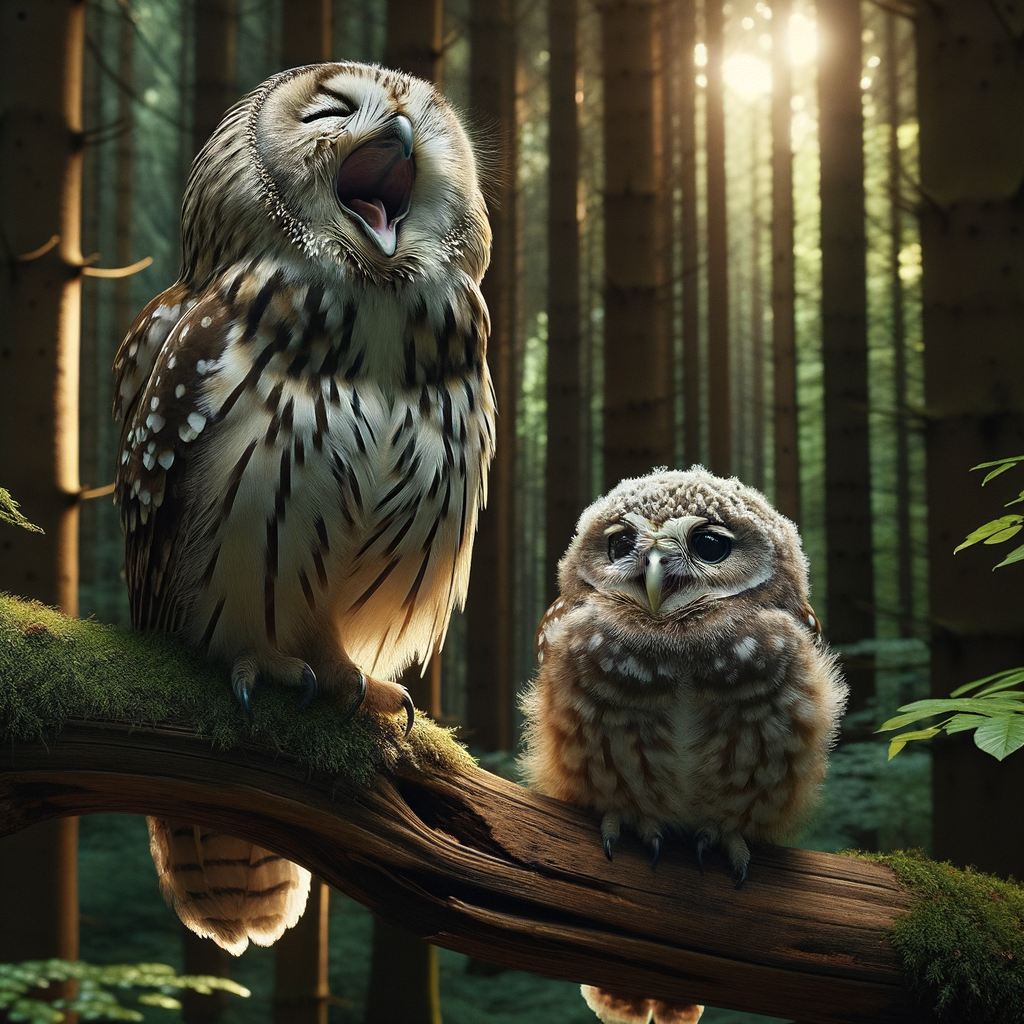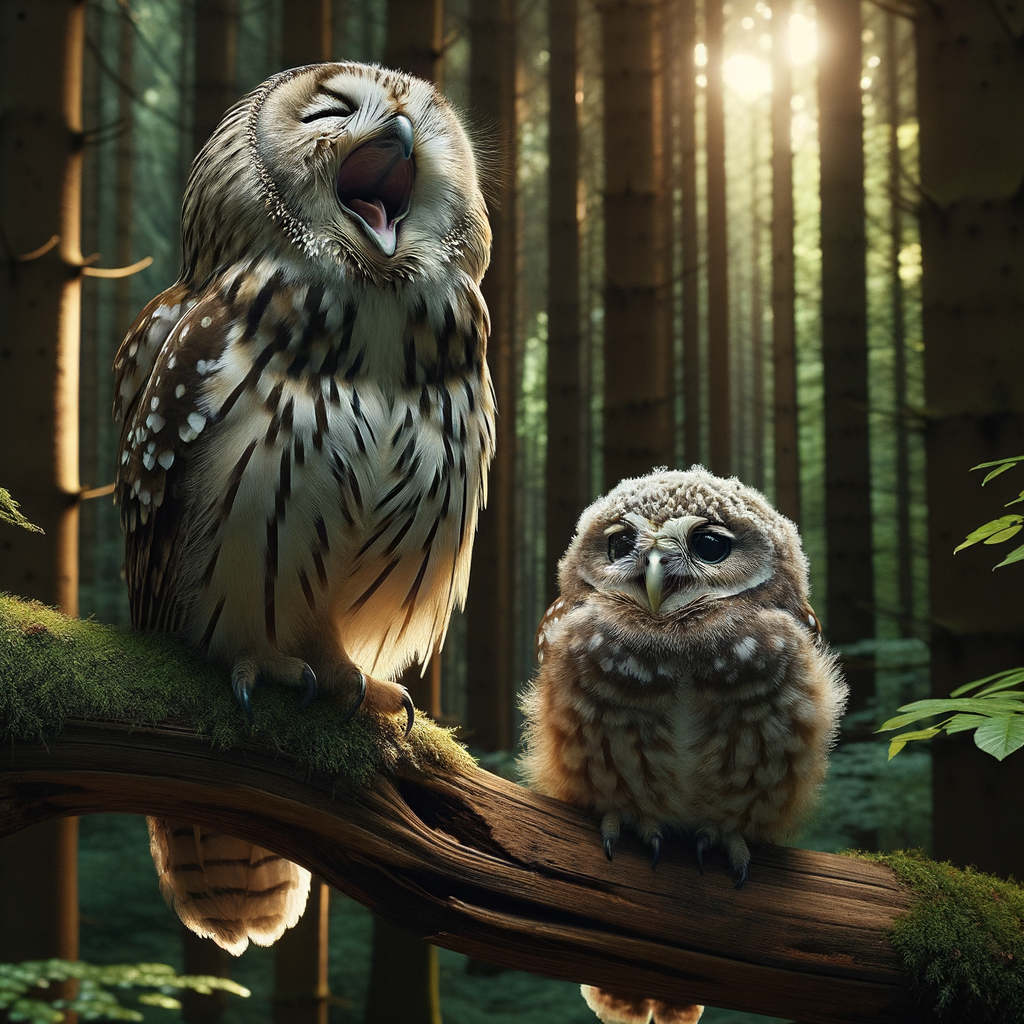
Introduction to Owl Communication
- Overview of owls communication methods: Owls use various ways to communicate with each other. They hoot, screech, and make other sounds. They also use body language, like fluffing their feathers or bobbing their heads.
- Importance of communication in owl’s life: Communication is very important for owls. It helps them find mates, protect their territory, and warn each other of danger. Without good communication, owls would have a hard time surviving.
Owl Vocalizations
Owl Hooting Patterns
-
Common owl hooting patterns
Owls are known for their unique hooting sounds. These sounds can vary greatly between species. For example, the Great Horned Owl often makes a series of deep, stuttering hoots: “hoo-h’HOO-hoo-hoo.” In contrast, the Eastern Screech-Owl has a trilling call that sounds like a horse whinnying. Each species has its own distinct pattern.
-
Interpretation of different hooting patterns
Understanding these hooting patterns can tell us a lot about owl behavior. For instance, a series of rapid hoots may indicate that an owl is defending its territory. A softer, more rhythmic hoot might be a call to a mate. By listening carefully, researchers can learn about owl activities and social structures.
Owl Calls in Nature
- Types of Owl CallsOwls make different sounds. These sounds are called calls. Here are some common types:
- Hoots: The most common sound. It is deep and soft.
- Screeches: High-pitched and loud. Often used by young owls.
- Whistles: Soft and short. Used for communication between mates.
- Barks: Sharp and quick. Used to warn other owls.
-
Function of Different Calls
Each call has a purpose. Here are some reasons why owls make different calls:
- Hoots: To mark territory. It tells other owls to stay away.
- Screeches: To call for help. Young owls use it to get their parents’ attention.
- Whistles: To communicate with a mate. It helps them stay connected.
- Barks: To warn of danger. It alerts other owls to predators.
Owl Signaling Behaviors
Owl Body Language
-
Common owl body language signals
- Fluffed feathers: When an owl fluffs its feathers, it may be trying to look bigger to scare off predators.
- Head bobbing: Owls often bob their heads to get a better view of their surroundings.
- Wing stretching: Stretching wings can be a sign of relaxation or a way to cool down.
-
Interpretation of different body language signals
- Fluffed feathers: This usually means the owl feels threatened or is trying to intimidate others.
- Head bobbing: This behavior helps owls judge distances and focus on objects.
- Wing stretching: This can indicate that the owl is comfortable and at ease in its environment.
Owl Mating Calls
Owl Mating Calls
These calls are different from other sounds they make. Each species of owl has its own unique mating call. These calls help owls find each other in the dark. For example, the Barn Owl has a screeching call, while the Great Horned Owl has a deep hooting sound.
Role of Mating Calls in Owl Reproduction
These calls help male and female owls find each other. Once they find each other, they can start a family. The male owl often calls first. If a female likes the call, she will respond. This back-and-forth calling helps them bond.
Mating calls also help owls choose the best mate. Strong, clear calls can show that an owl is healthy. This is important because healthy parents can take better care of their young.
| Owl Species | Mating Call Description |
|---|---|
| Barn Owl | Screeching sound |
| Great Horned Owl | Deep hooting sound |
| Eastern Screech Owl | Whinnying call |
Owl mating calls play a key role in their reproduction. These calls help owls find and choose mates. They also ensure that the owls can start a family and take care of their young.
Owl Territory Calls
-
Owl Territory Calls
Owls use special sounds called territory calls to mark their area. These calls tell other owls, “This is my space!” Each owl has its own unique call. This helps them recognize each other.
For example, the Great Horned Owl has a deep hoot. The Eastern Screech-Owl makes a trilling sound. These calls can be heard from far away, especially at night.
Owl Species Territory Call Great Horned Owl Deep Hoot Eastern Screech-Owl Trilling Sound According to Wikipedia, the Great Horned Owl’s call can be heard up to several miles away. This helps them communicate over long distances.
-
Role of Territory Calls in Owl Survival
They help owls find and keep their own space. This space is where they hunt for food and raise their young.
Without territory calls, owls might fight over space. This can be dangerous. By using calls, they can avoid these fights. It also helps them find a mate. A strong, clear call can attract a partner.
In a study, scientists found that owls with louder calls had better chances of survival. This is because they could defend their territory better. They also had more food and safer places for their nests.
In summary, territory calls are like an owl’s address. They keep them safe and help them thrive in the wild.
Owl Communication Research
Latest Findings in Owl Communication
-
Recent studies on owl communication:
These sounds include hoots, screeches, and whistles. Each sound has a different meaning. For example, a hoot can signal territory, while a screech might warn of danger.
-
Implications of latest research:
The new findings help us understand how owls interact with each other. Knowing their communication methods can aid in conservation efforts. It also helps bird watchers and researchers identify owl species by their calls.
| Type of Sound | Meaning |
|---|---|
| Hoot | Territory |
| Screech | Warning |
| Whistle | Attracting a mate |
Owl Sound Identification
Guide to Identifying Owl Sounds
- Common owl sounds and their meaningsOwls make different sounds to communicate. Here are some common ones:
- Hooting: This is the classic owl sound. It often means the owl is marking its territory.
- Screeching: A high-pitched sound that can mean the owl is scared or warning others.
- Whistling: Some owls whistle to attract mates or call their young.
- Chirping: This sound is usually made by baby owls to get attention from their parents.
-
Tips for identifying owl sounds in the wild
Identifying owl sounds can be tricky. Here are some tips to help you:
- Listen at night: Owls are nocturnal, so they are most active after dark.
- Use a field guide: A guide can help you match sounds to specific owl species.
- Record the sounds: Use a recording device to capture the sounds. You can compare them later.
- Be patient: Owls may not call right away. Wait quietly and listen carefully.
| Sound | Meaning |
|---|---|
| Hooting | Marking territory |
| Screeching | Fear or warning |
| Whistling | Attracting mates or calling young |
| Chirping | Attention-seeking by baby owls |
Conclusion
- Summary of Key Points on Owl Communication:Owls use a variety of sounds and behaviors to communicate. They hoot, screech, and make other noises to signal different things. Owls also use body language, like fluffing their feathers or bobbing their heads, to send messages.
- Importance of Continued Research on Owl Communication:Studying how owls communicate helps us understand these amazing birds better. It also helps in conservation efforts. By learning more, we can protect their habitats and ensure they thrive.






